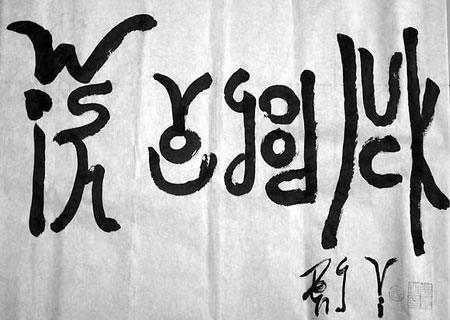
A piece of Deng Shenyi's work which reads "Wish you good luck". Below: Deng Shenyi says for Westerners, square English is art, while for Chinese, it's a new and fun way to learn English. Photos by Zhang Wei / China Daily
When Deng Shenyi used a brush to write calligraphy in New York City in 2008, most of the audience couldn't understand the pictographic words.
"Although they look like ancient Chinese, they are all English words written in a Chinese style," said Deng, a member of the China Association of Inventions.
"On a second look, one can identify these words," said Deng, 49. "After my explanation, the audiences began to understand the words and tried to read them aloud."
He calls this new artistic form "square English", a combination of the English language and Chinese calligraphy.
Like Chinese characters, each square English word is the same size, no matter the number of letters. The English letters are like the parts of Chinese character, and the writing sequence is from top to bottom, and left to right, following the path of Chinese characters.
"Culture can stimulate the development of society. I'm not changing Western culture, but promoting a Chinese thinking pattern. It's easier to promote Chinese calligraphy among foreigners too," he said.
Since 2008, his works have been exhibited in such places as Beijing, New York City and Las Vegas.
He spent about a month finishing the work of the Charter of the United Nations in square English, which was collected by the UN in 2008. He also wrote the works of English versions of Chinese classical poems, prose and novels.
"It's neat, pretty and saves paper. For the UN Charter, there are 117 pages in the English version, 95 in Chinese, but only 80 in square English," he said.
He said the calligraphy could also be promoted in other languages such as French and German.
"It's very creative. If the special calligraphy is promoted to the world, so is Chinese culture," said Gu Xiangyang, a calligrapher and professor from Peking University.
Deng said the writing of the 26 letters remains pretty much the same as in English, but they are assembled in different ways to make the words diversified.
Square English follows English grammar, too. For example, capitalized words in English remained capitalized.
In addition, Deng divides the words by syllables and writes one after another according to the writing sequence of Chinese characters.
"It's easy to pronounce the word when one sees the divided syllables, especially for Chinese, who are used to the top-to-bottom and left-to-right thinking pattern," he said.

Copyright ©1999-2011 Chinanews.com. All rights reserved.
Reproduction in whole or in part without permission is prohibited.